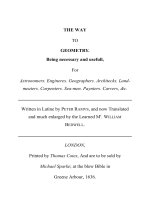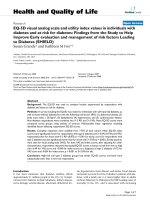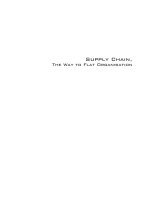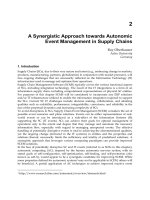Research results from the Advanced Lead–Acid Battery Consortium point the way to longer life and higher specific energy for leadracid electric-vehicle batteries pptx
Bạn đang xem bản rút gọn của tài liệu. Xem và tải ngay bản đầy đủ của tài liệu tại đây (359.64 KB, 5 trang )
Ž.
Journal of Power Sources 73 1998 122–126
Research results from the Advanced Lead–Acid Battery Consortium
point the way to longer life and higher specific energy for leadracid
electric-vehicle batteries
P.T. Moseley
)
The International Lead Zinc Research Organization, Post Office Box 12036, Research Triangle Park, NC 27709-2036, USA
Received 3 July 1997; accepted 10 October 1997
Abstract
Amidst the welter of publicity devoted to the newer battery chemistries, the remarkable progress made by leadracid battery
technologists in response to the needs of the emerging electric-vehicle market has tended to be overlooked. The flooded design of battery,
launched by Gaston Plante around 1860, has given way to a valve-regulated variant which has a history dating only from the 1970s. The
´
key parameters of this ‘maintenance free’ battery have been improved markedly during the course of the development programme of the
Ž.
Advanced Lead–Acid Battery Consortium ALABC , and it is likely that leadracid will continue to feature strongly in motive-power
applications as a result of its cost advantage and of its enhanced effectiveness. q 1998 Elsevier Science S.A. All rights reserved.
Keywords: Leadracid battery; Valve-regulated; Electric vehicle; Cycle life; Specific energy; Rapid recharge
1. Electric-vehicle battery essentials
Electric vehicles have a history which spans the whole
length of the twentieth century. At the beginning of the
century, electric automobiles competed successfully with
vehicles powered by the immature internal combustion
engine. In 1973, and again in the early 1980s, international
concerns over crude-oil supplies regenerated an enthusi-
asm for the development of a means of transport that was
no longer directly dependent upon hydrocarbon fuels. Pro-
gressively since that time, there has been an added motiva-
tion arising from widespread concern over increasing at-
mospheric pollution in urban communities. In 1996, do-
mestic oil consumption in the USA was over 18 M barrels
wx
per day, of which 46.2% was imported 1 and over half
wx
was consumed in internal-combustion-engined vehicles 2 .
This level of dependence on overseas oil is of concern
because it is expected that a permanent decline in global
wx
oil production rate will begin within 20 yr 3 . Further,
today, more than half the US population live in areas that
wx
do not comply with national ozone standards 4 . These
twin motivations for developing a means of transport that
)
Corresponding author. Tel.: q1-919-361-4647; fax: q1-919-361-
1957.
does not depend upon crude oil supply have never been
stronger. The key to a successful contribution being made
by an electric automobile, however, is the manner in which
customer expectations will be met, essentially by compari-
son with the equivalent internal-combustion-engined vehi-
cle.
Customer acceptance of the electric vehicle as an alter-
nate means of transport awaits the provision of a full
charging infrastructure, but is also bound to be strongly
influenced by the vehicle costrperformance ratio. Once
the vehicle manufacturing cost is able to benefit from the
economies of scale, it is widely felt that the electric vehicle
will cost no more than the internal-combustion engined
vehicle; perhaps less, since it will involve fewer moving
parts. Service costs, too, may be lower for the electric
vehicle, except that tyre replacement may be required more
frequently. The major focus of the pricerperformance
issue has been the vehicle’s main battery—the energy-
storage system that will replace the fuel tank of the
internal-combustion-engined vehicle.
An acceptable battery will need to exhibit at least the
following attributes:
- low purchase price
Ž
- high specific power in order to provide the vehicle
.
with adequate acceleration
0378-7753r98r$19.00 q 1998 Elsevier Science S.A. All rights reserved.
Ž.
PII S0378-7753 98 00029-9
()
P.T. MoseleyrJournal of Power Sources 73 1998 122–126 123
Table 1
Raw materials prices, production and consumption for nickel and lead in 1997
Ž . Ž. Ž.
London metal exchange price US¢rlb Western production MMT Western consumption MMT
Nickel 340 730 915
Lead 32 4.8 5.1
Ž.
- good cycle life to provide low lifetime costs
Ž.
- good specific energy range per charge
Ž.
- ability for rapid recharge for maximum availability
- low self-discharge
- high energy efficiency
- high recyclability
- safety.
There has been much discussion over the appropriate
ranking of these several factors. A preoccupation with
specific energy has been the major driving force for the
interest in novel battery chemistries in recent years, but an
Ž
appreciation of the likely costs for example, see materials
.
costs shown in Table 1 tends to restore interest in the
leadracid battery as a prime contender for electric vehicles
particularly since, as will be shown below, this system can
be rapidly recharged. The leadracid battery also exhibits
Ž
good specific power so that the General Motors EV1 is
able to offer an acceleration of zero to 60 mph in less than
.
9 s , energy efficiency, recyclability and safety. Much
development work has been devoted to maximizing spe-
cific energy and cycle life, as well as to exploring the
prospects for rapid recharge, through the function of a
world-wide collaboration by the Advanced Lead–Acid
Ž.
Battery Consortium ALABC .
2. The Advanced Lead–Acid Battery Consortium
The responsibility for ensuring that the best possible
leadracid batteries become available to support the grow-
ing electric-vehicle market has been accepted by the AL-
ABC. This organization comprises 90% of the world’s lead
producers, 85% of the leadracid battery manufacturers,
and a variety of companies from related industrial sectors.
This vertically integrated group came together in 1992
with the declared aim of making electric vehicles a reality
within a decade. It is not the purpose of the ALABC itself
to design the ultimate electric-vehicle battery. Rather, the
aim of the ALABC is to foster a central R&D program for
all its members to use as a ‘research pool’ to assist their
own battery development activities, both for electric vehi-
cles and for other applications. In other words, the AL-
ABC is an open resource—the research results are dissem-
inated freely to the members and thus benefit the industry
as a whole. In this respect, European, North American and
Pacific Rim members take the most promising outcomes
from their respective research programmes and work to-
gether to build a new generation of leadracid batteries.
As a starting point, it was decided that the electric-
vehicle battery must be maintenance free. Thus, the flooded
leadracid battery that was introduced around 1860 was set
aside in favour of the valve-regulated design that appeared
during the 1970s.
Benefitting from research results of the ALABC pro-
grammes, advanced valve-regulated leadracid batteries are
already capable of meeting all but one of the mid-term
criteria of the US Advanced Battery Consortium. Existing
and commercially available advanced leadracid batteries
are capable of providing electric vehicles with daily com-
muting ranges of 90 mile or more, recharging times of a
few minutes, and lifetimes of approximately 3 yr.
As indicated in Table 2, the fuel cost per mile of
running a leadracid powered electric vehicle has already
dropped by an order of magnitude during the course of the
Table 2
Key parameters for leadracid batteries for electric vehicles
a
Purchase Specific Specific energy Recharge time Cycle life Cost of ownership
y1
Ž. Ž.
price power W h kg r cycles US$rmile
y1
Ž.Ž. Ž.
US$rkW h W kg range mile
ALABC targets 150 150 50r100 50%, 5 min 500 0.07
80%, 15 min
100%, 4 h
1992 200 150 25r50 100%, 8 h 75 1.07
1995 150 150 35r75 50%, 5 min 500 0.10
80%, 15 min
100%, 4 h
1998 100 150 48r100 50%, 3 min 800 0.04
80%, 10 min
100%, 30 min
a
Ž. Ž . Ž . Ž .
Assumptions; i US$0.10rkW h for electricity; ii 16 kW h battery in vehicle; iii 80% efficiency; iv 80% depth-of-discharge.
()
P.T. MoseleyrJournal of Power Sources 73 1998 122–126124
ALABC’s programme. Assuming energy costs at
US$.10rkW h, fuel costs will drop further to US$0.04 per
mile in 1998 and make the EV running cost competitive
with the cost of fuelling a conventional internal-combus-
Ž.
tion-engined ICE automobile.
Towards the end of 1996, General Motors introduced
the EV1 for public acquisition in California and Arizona.
The vehicle was powered by a valve-regulated leadracid
battery. At about the same time, a further 3-year pro-
Ž.
gramme 1997–1999 was set in place by the ALABC
with membership that had expanded to 58 companies and
organizations world-wide.
Progress in improving the parameters shown in Table 2,
that are all to be achieved with the valve-regulated
leadracid battery, is described in Section 3.
3. Advances in valve-regulated leadr
rr
rr
acid electric-
vehicle battery technology
The major advances in the development of valve-regu-
lated leadracid batteries for electric-vehicle applications
have taken place in the areas of cycle life, specific energy,
and rapid recharge.
3.1. Cycle life
When the valve-regulated leadracid battery was first
operated under deep-discharge duty, cycle life was often
found to be very short. Two mechanisms for this so-called
‘premature capacity loss’ were proposed: the first sug-
gested the formation of a high-resistance corrosion layer at
Ž.
the surface of the current-collector grid ; the second in-
volved a degradation of the microstructure of the positive
active-mass that resulted in a breakdown of inter-particle
connectivity. Elegant experiments carried out by the re-
search team at the Technical University of Brno showed
that there was a strong correlation of the progressive fall in
capacity as the battery was cycled with the decrease in the
conductance of the active mass, but that there was no
correlation with the conductance of the interphase between
wx
the grid and the active mass 5 . This observation was
found to hold both for grids based on lead–antimony
alloys and for grids based on lead–calcium–tin alloys.
wx
Meanwhile, Hollenkamp 6 articulated a unified theory to
explain premature capacity less entirely in terms of degra-
dation of the positive active-mass microstructure. This
degradation process undoubtedly arises from the tendency
of the active mass to swell at each discharge because the
molar volumes of the discharge products are substantially
greater than those of the charged materials. It appears that
this mode of failure can be overcome by putting the active
material under sufficient constraint to prevent it from
swelling during deep-discharge cycling. In the plane of the
battery plate it is the creep resistance of the grid alloy that
wx
is the key 7 . The replacement of lead–antimony alloys by
lead–calcium alloys when valve-regulated designs were
introduced reduced the creep resistance by a substantial
factor and it was soon found that swelling of the active
material caused the grids to grow substantially during the
course of their deep-discharge cycled life. ALABC’s con-
wx
tractors in France 8 have shown that the addition of 1 to
1.5 wt.% tin to the lead–calcium alloy and the use of a
degree of work to the manufactured grid surface largely
restored the creep resistance of the grid and prevented grid
growth. In the direction perpendicular to the plane of the
plate, the prevention of swelling of the active mass de-
pends upon a compressive force applied to the stack as a
wx Ž.
whole 7 . In this connection, recent results Fig. 1 illus-
trate the effectiveness of applying adequate compressive
force to the plate stack in order to ensure a long deep-cycle
life. Here, it is important to recognize that the improve-
ment resulting from the use of the better stack compression
applies equally well for lead–antimony and lead–calcium–
tin grids. A crucial factor in such considerations is likely to
be the physical performance of the AGM separator. Evi-
dence is beginning to emerge from the research pro-
wx
gramme at CSIRO in Australia 9 that the application of
high pressures to AGM separators that are presently in
commercial use results in separator distortion so that much
of the compressive force applied to the stack is dissipated
by collapse of the separator rather than being applied to
the active mass as intended. Development of adequate
separator materials, applied in an optimum fashion is
Fig. 1. Effect of compression on the 100% DoD cycle life of two types of
flooded cells with Pb—0.08 wt.%, Ca—0.3 wt.%, Sn and Pb—1.6 wt.%
Ž.
Sb positive grids, respectively, discharged at the 3-h rate. a 8 kPa
Ž. Ž Ž
compression; b 40 kPa compression. Data taken from ALABC CSIRO
.
Project No: AMC-007 .
()
P.T. MoseleyrJournal of Power Sources 73 1998 122–126 125
clearly a vital area requiring optimization if long cycle
lives are to be maintained.
In summary, therefore, the achievement of long cycle
life by overcoming premature capacity loss requires atten-
Ž.
tion to at least three factors: i compression of the stack in
Ž.
a direction perpendicular to the plane of the plate; ii the
use of alloys with sufficient creep resistance to prevent
Ž.
growth in the plane of the plate; iii accurate control of
Ž.
the charging process, see below .
3.2. Specific energy
Two major approaches to improving the specific energy
of the system are to reduce the weight of the structural
components of the cell and to improve the utilization of
the active materials. The latter depends upon choosing a
design of cell with minimal diffusion lengths and possibly
Ž.
Fig. 2. Addition of tin and silver to lead–calcium alloys; a decrease in
the weight loss during a 5-day test as tin content of Pb—0.1 wt.%,
Ž.
Ca—0.6 wt.%, Sn—0.01 wt.% Ag alloy is increased; b increase in time
Ž.
to creep failure at 27 MPa as tin and silver are added to Pb—0.08 wt.%,
Ca—0.6 wt.%, Sn—0.03 wt.% Ag alloy and as the casting operation is
wx
followed by rolling 8 .
Fig. 3. Charging characteristics of a VRLA battery recharged according
Ž
to an interactive pulsed-currentrconstant-voltage algorithm. Data taken
.
from ALABCrCSIRO Project No. RMC-008 .
the deployment of additives that enhance electrolyte sup-
ply. The gravimetric issue can be addressed by utilizing
lower gauge grids which combine improved corrosion
Ž
resistance so that less sacrificial material needs to be
.
provided with high strength. Fortunately, the alloys which
wx
have been developed with increased tin content 8 do
indeed combine these two virtues. Fig. 2a shows how the
corrosion weight loss during a period of 5 days exposure
decreases with increasing tin content of a lead–calcium
alloy, and Fig. 2b shows how the creep resistance in-
wx
creases with increasing tin 8 .
Projects within the new ALABC programme are di-
rected towards making use of these alloys in batteries with
thin grids and flat plate or tubular plate design in order to
achieve long life together with high specific energy.
3.3. Rapid recharge
Although it flies in the face of conventional wisdom to
wx
do so 10 , a significant effort in the ALABC programme
has been devoted to recharging deep-discharged valve-reg-
ulated leadracid batteries in the shortest possible time.
The initial incentive for this work was as a convenient
means of offsetting the somewhat limited range achievable
with a battery offering a specific energy of no more than
about 50 W h kg
y1
. Despite the so-called ‘Ampere-Hour
wx
Rule’ 10 , it was quickly found that valve-regulated batter-
Ž
ies can be substantially charged within a few minutes Fig.
. wx
3 . In fact, repeated treatment in this way has shown 11
that it leads to a substantial increase in cycle life. The
origins of this improvement are being vigorously sought in
ongoing technical programmes, but the early indications
are that rapid recharge produces an active material with a
small particle size and much higher surface area than does
Ž.
regular charging Fig. 4 . This is probably the reason for
the increase in line broadening which occurs in X-ray
powder diffraction patterns of lead dioxide charged at
()
P.T. MoseleyrJournal of Power Sources 73 1998 122–126126
Ž.
Fig. 4. a High-rate charging of VRLA batteries restores the positive
active material in a high surface area form characterized by a needle-like
Ž.
habit. b When the battery is recharged at lower rates the positive active
Ž
material forms larger particles. Data taken from ALABCrCSIRO Project
.
No. AMC-009 .
higher rates. It is therefore possible that fast charging may
produce a bonus benefit beyond its original purpose. The
utility of fast charging as a means of daily range extension
has been dramatically illustrated in December 1996 by a
team from Delphi-E and Aero Vironment who drove an
electric vehicle a distance of 1025.5 mile within 24 h on
the streets and highways of Los Angeles. This demonstra-
tion illustrates that, with the convenience of fast charging,
an electric vehicle equipped with leadracid batteries suf-
fers no significant range limitation during a day’s drive.
4. Conclusions
The present state of the technology indicates that, with
the projects currently in train, valve-regulated leadracid
batteries with a performance anticipated in Table 2 are on
schedule for development before the end of 1998. The
achievement of such a performance will represent a spec-
tacular advance by the leadracid battery community dur-
ing the course of the 1990s and offers the prospect of an
electric automobile with a range per charge of over 100
mile, repeatable several times within a day and over 500
times during the lifetime of a battery pack.
References
wx
1 USDOE Energy Information Agency, 1996.
wx
2 D. Sperling, Scientific American, Nov. 1996, pp. 54.
wx Ž.
3 C.B. Hatfield, Nature 387 1997 121.
wx
4 J.J. McKenzie, R.C. Dower, D.D.T. Chen, The Going Rate: What it
Really Costs to Drive, Word Resources Institute, Washington, DC,
June 1992.
ˇ
wx
5 M. Calabek, K. Micka, P. Baca, P. Krivak, V. Smarda, J. Power
´ˇˇ´
Ž.
Sources 67 1997 85.
wx Ž.
6 A.F. Hollenkamp, J. Power Sources 59 1996 87.
wx Ž.
7 P.T. Moseley, J. Power Sources 67 1997 115.
wx
8 L. Albert, A. Chabrol, L. Torcheux, Ph. Steyer, J.P. Hilger, J. Power
Ž.
Sources 67 1997 257.
wx
9 K. McGregor, M. Barber, A.F. Hollenkamp, T.D. Huynh, A.J.
Urban, J. Power Sources, in press.
wx
10 H. Bode, Lead–Acid Batteries, Wiley-Interscience, 1977.
wx
11 T.G. Chang, D.M. Jochim, J. Power Sources, 1997, in press.









